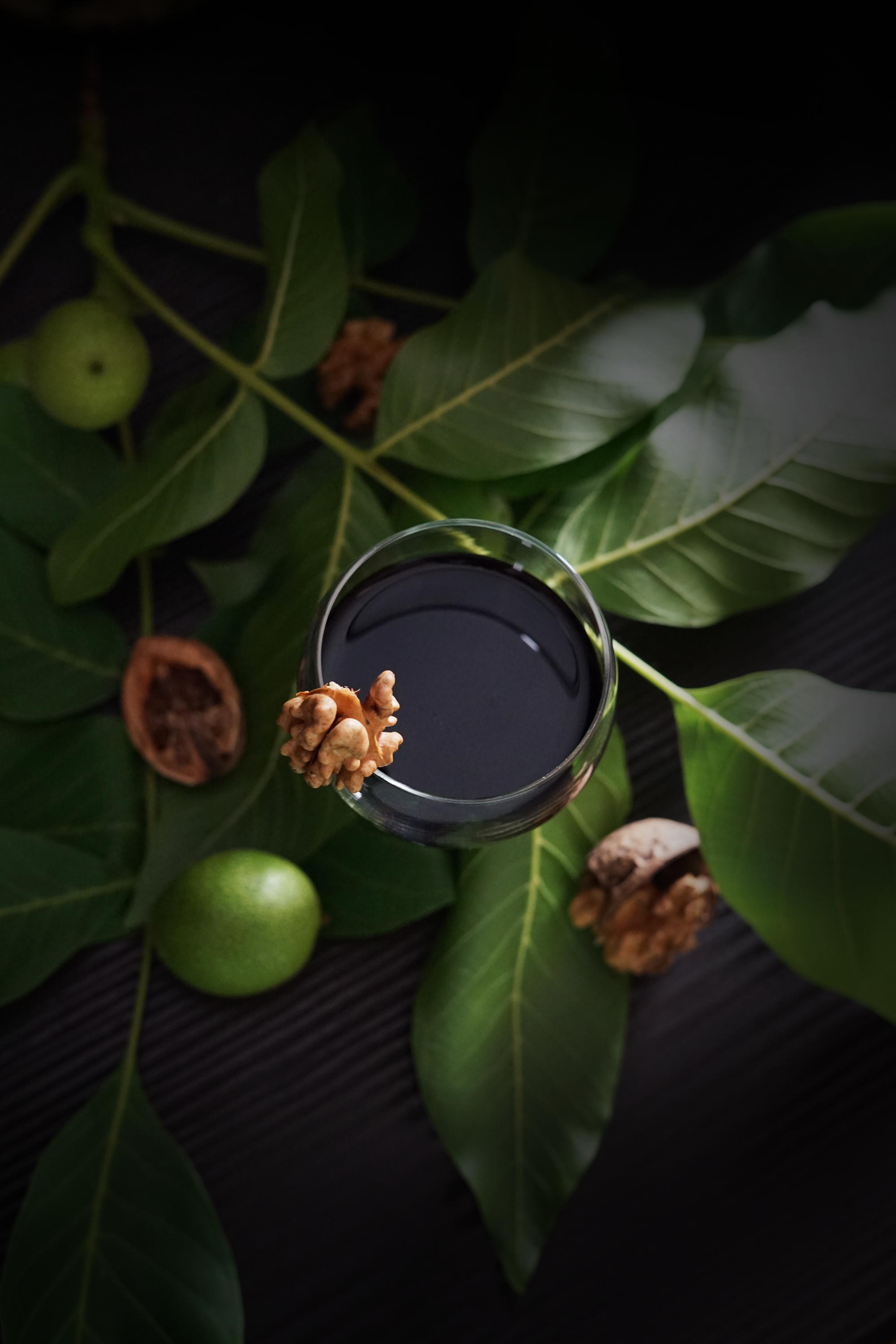Walnuts, Witches, And Duality - Nocino and Pickled Green Walnuts
There are two points in the year when our attentions are particularly drawn to dualities: the Summer Solstice and the Winter Solstice. These correspond to the longest day of the year and the shortest. Therefore, it’s particularly appropriate to focus on those energies in tandem, harnessing the beautiful plants and flavors of summer to tuck away and enjoy during the long nights of winter. On the longest day of the year, it seems only fitting to be reminded of the darkness. This yearly dance keeps us in balance.
Perhaps one of the best projects for this is making Nocino, which is an Italian liqueur made from green walnuts. It’s tradition to begin infusing the walnuts (and maybe a few spices if you’d like) on the Summer Solstice (or Saint John’s Day, June 24th.), then share the spiced tipple with loved ones in the darkness of winter to ward off evil spirits lurking in the night and warm both tummies and soul. Likewise, the walnuts begin as a vibrantly green infusion, which then darkens to an almost-black liquid by the time you drink it. Nocino was supposedly invented at a congress of witches, and legends instruct that the soft green walnuts should be harvested while barefoot, preferably by virgin women after nightfall, and in uneven numbers. (Though I can personally confirm that none of these things are strictly necessary to make a tasty brew!) Other legends say that it originated among the Picts of Scotland, then brought to Italy by the Romans when they left Britain behind. In any case, Nocino is like a warm hug, enveloping you in a sweat spiciness and warming you to your core. It’s almost as thought you’ve bottled up all of the warmth of early summer to sip on those long winter nights. Nocino can be drank as a digestive after an evening meal, and is also great with an after dinner cheese course or poured over vanilla ice cream for a seductive dessert.
Walnuts are another representation of duality:
“It is necessary, in considering the folklore of the Walnut, to separate the tree from the nut. The tree is feared as a tree of ill omen, and is regarded as a favourite haunt of witches. The shade of the Walnut-tree was held by the Romans to be particularly baneful. The Black Walnut will not let anything grow under it, and if planted in an orchard will kill all the Apple-trees in its neighbourhood. The Nut is, on the contrary, considered propitious, favourable to marriage, and the symbol of fecundity and abundance.” - p. 583 in Plant Lore, Legends, and Lyrics by Richard Folkard
Richard goes on to mention one of the most famous walnut trees in folklore, the Benevento walnut in Italy. “At Bologna, the peasantry think that witches hold a nocturnal meeting beneath the Walnut-trees on the Virgil of St. John. But among all other Walnut-trees, the most infamous and the most accursed is the Walnut of Benevento, regarding which there are many tales of its being haunted by the Devil and witches.” (584) This tree became a symbol to the people that knew of it, and legends flew of witches gathering under the tree for their pagan festivals and secret meetings. Walnuts indeed were sacred to witches due to their inherent strengths: walnuts are able to weather very harsh conditions and still bear fruit, plus they are self-sufficient hermaphrodites.
Perhaps these dark associations are due to the juglone that walnut trees contain. This substance is responsible for both the dark color of walnut hulls as well as the suppressant properties that prevent most other plants from living below a walnut tree. But walnuts are not all dark: their ripe nuts are rich, healthy, and delicious, providing our bodies (especially our brains) with nutrients and strength. Walnuts are also associated with protection and safeholding, such as in the stories Tom Thumb and Thumbelina where tiny beings are kept safe within their hard shells. Nocino has been a traditional drink of the marriage toast in various areas in Europe as well, highlighting walnuts association to fertility once again.
While many are familiar with the ripened nuts and all of their delicious uses, the use of unripe green walnuts seems to have fallen by the wayside. This is a shame, since green walnuts have an unmistakable and absolutely delightful flavor that is equally delicious in sweet and spicy Nocino and as a flavorful pickle. Pickled green walnuts are rich, tangy, and zesty … to me, they taste like steak sauce. They’re a wonderful addition to a cheese plate or ground into a sauce and served with meat. Give both recipes a try to acquaint yourself with another side of Walnut’s character!
Nocino:
I like to keep my Nocino recipe fairly simple to really let the flavor of the walnuts shine, but you can add more spices if you’d like. Try warming spices such as cloves, cinnamon, or ginger. I’ve added a couple of wild spices to this recipe but they are entirely optional. Make your blend your own!
Ingredients:
33 green walnuts
1 liter high-proof vodka
1/2 vanilla bean
1 tsp. crushed dried spice bush berries (or allspice)
1 tsp. crushed dried sweet woodruff
zest from one lemon cut into strips
1 c. sugar
1 c. water
Directions:
- Cut the walnuts into quarters. You’ll want to wear gloves and use a plastic cutting board (or old piece of wood) for this task, as the hulls can stain a dark brown that is very difficult to wash out of skin or wood.
- Add the walnuts, vanilla, spice bush, sweet woodruff, lemon zest, and vanilla bean to a large sterilized glass jar and top with the vodka. Leave somewhere dark for two months, shaking every week or so.
- After two months, cook the sugar and water over low heat until the sugar dissolves into a syrup and let it cool.
- Strain the alcohol and discard the solids, then mix it with the cooled sugar syrup. Run the mixture through a coffee filter or nut milk bag to remove the particulates and keep the mixture clear.
- Bottle and seal, then let sit for at least 4 more months and up to 2 years to mellow before drinking. Enjoy on the Winter Solstice or save for the next year’s Summer Solstice celebrations.
If using two big jars rather than one giant one:
Fill each 3/4 with quartered walnuts. Top with vodka. Add 1/2 vanilla bean, 1/2 tsp. crushed dried spice bush berries (or allspice), 1/2 tsp. dried sweet woodruff, and a couple strips of lemon zest. Proceed to step 3.
Pickled Walnuts:
These are a wonderful condiment to red meat, similar in flavor to steak or Worcestershire sauce. Use whole green walnuts and be sure to harvest them before the shell has formed. You can test their ripeness by inserting a metal skewer; it should pass all the way through the nut without difficulty but the green nuts should be round and plump.
Ingredients:
27 green unripe walnuts
1/4 c. kosher salt
1 quart water
1 quart cider vinegar
1/2 c. brown sugar
2 tsp. cracked black peppercorns
2 tsp. cracked allspice berries
1 tsp. fresh ginger, grated
- Wearing gloves to prevent staining your hands, stab each walnut with a fork a few times and set aside.
- Dissolve the salt in the water to make a brine, then submerge the stabbed nuts in the brine and top with a heavy ceramic plate to keep them submerged. Let sit at room temperature for 1 week.
- Remove the walnuts and spread them out on a sheet in the sun to dry for about a day, turning every few hours. They should be evenly blackened. (Keep in mind that they’ll stain any fabric they come into contact with, so be sure to use an old sheet!)
- Clean and sterilize some pint or quart canning jars, then pack the dried walnuts into the jars.
- Bring the remaining ingredients to a boil and pour over the walnuts, leaving 1/4” headspace. You can store them in the fridge for 6 months or can for longer storage.
- To water-bath can: Heat a large pot of water over high heat until it’s boiling while you boil the vinegar solution as well. As soon as you pour the vinegar mixture over the walnuts, place the sterilized lids on the jars and lightly screw them on. Submerge the jars in the boiling water for 10 minutes, then remove and let cool. Once the jars have cooled and the lids are sealed (they should not give when you press on them), screw the lids on tightly and store somewhere dark and cool.
Try eating these nuts alone, sliced into thin slices. They are absolutely fantastic with cheddar cheese! You can also use them in flavorful sauces.To make a sauce: either save out the vinegar or puree the nuts and add other flavorings such as vinegar, wild garlic, fennel, horseradish, shallots, garlic, molasses, soy sauce, or tamarind paste.
As always, if you enjoy my posts, please consider contributing to my patreon fund so that I can continue to share them openly and publicly!




















Join me for a little winter night magic as we bake this cake full of rich seasonal flavors and black cocoa!